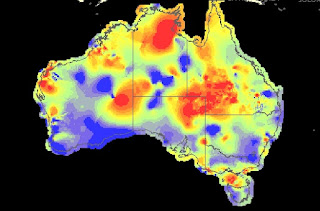So i had a friend of mine ask me about carbon reduction and jobs. He seems like an intelligent guy, but i felt the need to give him a fuller picture. While reports (from the mining industry) that predict job losses of 23,500 in mining (by 2030) might look scary, there's 3 crucial elements that reveal this as scaremongering:
1. The head of the Mining Worker's Union, Tony Maher (who has had frightened members ringing him up) has read the report and reveals that the report predicts 120% growth in Queensland and 60% growth in NSW. The jobs figure relates to extra jobs that might have happened if we continued to pollute regardless. (audio interview here)
2. The Climate Institute report (described as "the good news the polluters don't want you to hear") shows that up to 30,000 jobs would be created in renewable energy alone - with over $30 billion dollars in investment. And a lot of that will end up in regional Austalia.
3. An assessment done by the National Australia Bank shows that emissions reduction actually boosts the economy by around 6 billion dollars each year. If we're talking about 2020, then multiply that figure by 10 years.
It's one thing for the mining industry to whinge to government that avoiding climate change might lose them a few dollars, but to scare workers and manipulate people by playing on their biggest fear is something i find significantly distasteful.
Monday, May 25, 2009
Saturday, May 23, 2009
Save $700
The decision by President Obama to improve fuel consumption standards of American cars means that over the next 7 years, the average mileage will go from around 10 km/litre up to 15. As Obama points out, "Consumers pay less for fuel, which means less money going overseas, and more money to save or spend here at home".

So it makes sense that we would want the same thing here. The ACF and the NRMA outlined the benefits of Australia having a similar standard. Apart from reduced greenhouse emissions, it would keep the Australian car industry competitive internationally - in Japan the standard is 5L/100km (=20km/litre).
But probably the most obvious outcome is for the hip-pocket. Obviously, using 1/3 less fuel means paying 1/3 saving at the pump. NRMA found that fuel standards would save the average driver $700. Across Australia that's billions every year.

So it makes sense that we would want the same thing here. The ACF and the NRMA outlined the benefits of Australia having a similar standard. Apart from reduced greenhouse emissions, it would keep the Australian car industry competitive internationally - in Japan the standard is 5L/100km (=20km/litre).
But probably the most obvious outcome is for the hip-pocket. Obviously, using 1/3 less fuel means paying 1/3 saving at the pump. NRMA found that fuel standards would save the average driver $700. Across Australia that's billions every year.
See more about:
government,
petrol,
theworld,
transport
Friday, May 08, 2009
Spot The Difference
Apart from the obvious decoration, there is another difference between these two:

Only the front one is chewing up fuel during the long wait for the lights to change. The Prius hybrid only consumes fuel while moving (as sometimes not even then).

Only the front one is chewing up fuel during the long wait for the lights to change. The Prius hybrid only consumes fuel while moving (as sometimes not even then).
Tuesday, May 05, 2009
CPRS - The Sequel
No doubt you've heard about the Prime Minister's latest version of the Carbon Pollution Reduction Scheme. Part of the revision is another $1 billion to heavy polluters, taking the grand total to 8.4 billion dollars. This is more than double the money going into renewable energy.

The GetUp group reckon that a decent climate change strategy would be to allocate money to solving the problem (renewable energy) rather than to the companies who caused the problem in the first place. If you agree, why not sign the petition?

The GetUp group reckon that a decent climate change strategy would be to allocate money to solving the problem (renewable energy) rather than to the companies who caused the problem in the first place. If you agree, why not sign the petition?
See more about:
government,
renewables
Monday, May 04, 2009
Friday, May 01, 2009
Renewables Map
Discovered the Australian Renewable Energy Atlas - a map of the country's renewable resources are located.

No surprise that there's lots of solar and wind, but the picture here is of geothermal heat (the hot rocks deep under the surface). Areas as big as some states - at temperatures up to 300°C. So much energy!

No surprise that there's lots of solar and wind, but the picture here is of geothermal heat (the hot rocks deep under the surface). Areas as big as some states - at temperatures up to 300°C. So much energy!
See more about:
graphics,
info,
renewables
Subscribe to:
Comments (Atom)
